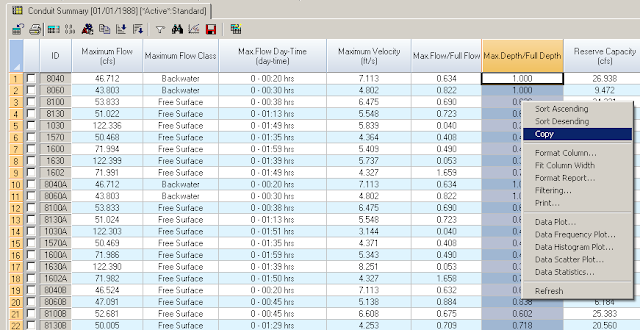Note: Static Gravity Main Report
Shows steady state simulation results for all gravity mains in tabular format. The report displays one record for each gravity main in the current H2OMAP Sewer project. Gravity main report columns include the Node Identifier, Total Flow, Unpeakable Flow, Peakable Flow, Coverage Flow, Infiltration Flow, Storm Flow, Flow Type, Velocity, d/D, q/Q, Water Depth, Critical Depth, Full Flow, Coverage Count, Backwater Adjustment, Adjusted Depth and Adjusted Velocity.
The following variables are displayed on the Static Gravity Main Report in the Output Report Manager
for all or selected gravity mains:
1. ID - Gravity main identifier.
2. From Node - ID of upstream node.
3. To Node - ID of downstream node.
4. Diameter - Inside pipe diameter for circular channels, in (mm).
5. Channel Depth - Maximum depth of a conduit (for non-circular channels only), in (mm).
6. Channel Width - Top/Bottom width of a conduit (for non-circular channels only), in (mm).
7. Channel Left Slope - Left side slope of a conduit (for trapezoidal and triangular channels only).
8. Channel Right Slope - Right side slope of a conduit (for trapezoidal and triangular channels only).
9. Length - Pipe length, ft (m).
10. Slope - Ratio of the change in vertical distance to the change in horizontal distance, unitless.
11. Total Flow - The summation of all flow types, flow unit.
12. Unpeakable Flow - The flow to which no peaking is applied, flow unit.
13. Peakable Flow - The flow derived based on the Federov peaking equation, flow unit.
14. Coverage Flow - The flow derived based on the Harman and Babbitt peaking equation in reference to the contributing population, flow unit.
15. Infiltration Flow - The volume of groundwater entering the sewer system from the soil through defective joints, broken or cracked pipes, improper connections, or manhole walls, flow unit.
16. Storm Flow - Peak storm load in the pipe, flow units.
17. Flow Type - Indicates if the flow is pressurized or free surface.
18. Velocity - The speed with which the water is traveling through the pipe, in ft/s (m/s).
19. d/D - The ratio of actual flow depth to the diameter of the pipe (full flow depth), unitless.
20. q/Q - The ratio of actual flow to the full flow as derived based on Manning's Equation, unitless.
21. Water Depth - The depth of water as it is flowing through the pipe, ft (m).
22. Critical Depth - The depth of water resulting when the Froude Number is equal to 1.0, ft (m).
23. Full Flow - The capacity of the pipe as evaluated based on Manning's Equation (when d/D = 1.0), flow units.
24. Coverage Count - The population parameter used in the Harman and Babbitt equations.
25. Backwater Adjustment – If the downstream head of the link is greater than the flow depth + the downstream pipe invert then the adjusted depth is one half of the sum of the water surface depth at the upstream and downstream ends of the link.
26. Adjusted Depth – The adjusted depth is the average of the upstream plus the downstream adjusted depth, where the upstream adjusted depth is the upstream head minus the upstream pipe invert elevation and the downstream adjusted depth is the downstream head minus the downstream pipe invert elevation. The adjusted depth is the minimum of the pipe diameter and the computed pipe adjusted depth.
27. Adjusted Velocity – the adjusted depth is used to calculate the wet area and adjusted velocity = flow/wet area.



































